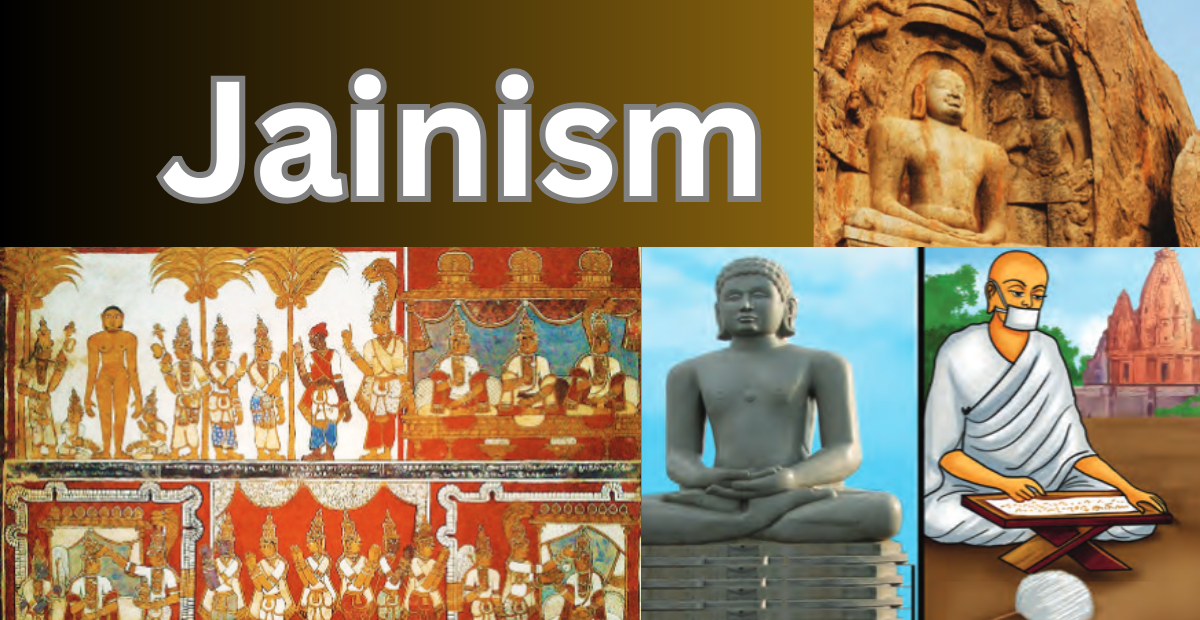Jainism
Introduction
Jainism taught us non-violence and self-discipline in our ancient Indian soil. Even today, Jainism roams the world as questions or rites, the life-ethics of the 24 teachers (theerthankaras) that make us understand everything. It is a religion that has given us the great weapon of non-violence. They held the deep view that one’s status in society is not determined by birth and it depends on the life one lives. Buddhism was formed based on their teachings.
The reason for the birth of Jainism.
It was the complex rituals and sacrifices recommended in the later Vedic period that encouraged the formation of Jainism.The rituals of sacrifices have to incur a large amount of expenses.Such questions and superstitions confused the ordinary people of practice.Therefore samanam was created in order to create a new awareness of slavery, the caste system and sexual analyses.Origins of Jainism Jainism is one of the oldest and presently living religions in the world.
Jainism consists of 24 teachers, i.e., 24 Tirthankaras.These Tirthankaras taught everyone the truths related to Madan of different periods.Rishabha was the first Tirthankara and the last Tirthankara was Mahavira. It was Rishabh who started Jainism.In the early days it was unimportant but jainism gained prominence under the guidance of Mahavira in the sixth century BC.Since Mahavira was called Jinar (conqueror of the world), his division was called Jainam.The word Jainism is derived from the Sanskrit word zina, which means one who conquers oneself and the outside world.
Mahavira(Varthamana):
His real name was Varthamana, a Kshatriya prince.He was born in a village called Kundagramam near Vaishali in 540 BC.His father, Siddhartha, was the head of the jnanathirika tribe.Her mother, Trishalai, is a Licchavi princess. Lisavi’s leader was also the sister of Chetkar.Varthamana was attracted to the spiritual way from an early age.After the death of his parents, it was he who, at the age of 30, renounced his position as prince and became a 12-year-old ascetic.
For six years, Gosala went with Maskariputra.Then he parted ways.Varthamana attained enlightenment (kevala) at the age of 42, when he was actively ascetic for 13 years.Or reached the nakedness.He was later called Jinar and Mahavira.Then they preached Jainism to everyone for 30 years.He died in 468 BC at the age of 72 at Pavapuri near Rajagraha.The Jains rejoiced that his death was his final destiny.
Divisions of Jainism:
500 years after Mahaviri’s death.b In 79 or 82 a division occurred in equanimity.
Digambaras:
- There was a severe famine in Magadha. Some Jain monks, led by Badrabahu, proceeded to the south to follow their heavy fasts .
- They went on a fast without any clothes .
- They were called digambaras (those who wore outer garments or were naked)
Shwetambaras:
- A group led by Stulabhadra remained in Magadha.
- They were dressed in flood clothes. Rajokarna (a small tudappam containing kambalai threads) was allowed to keep the begging utensils book.
- Jainism’s dominance in Magadha weakened due to this division.
- In Gujarat, Rajasthan, Madhya Pradesh, Odisha and Karnataka, there were ardent followers of Jainism.
The five great vows of Jainism are :
Ahimsa (ahimsa):
It was the basic principle of Jainism.Thoughts , actions, or words should not be made to cause suffering to any living being.
Sathya ( truth ):
Refers to the nature of truth.Those who speak harmless words are not deceivers and do not spread rumours.
Ashtiya (not stealing):
- They will avoid picking up their goods without someone’s
Abarikrusha (without possession):
Refers to possessiveness or detachment.It speaks of the importance of the detachment of the monks over possessions and their desires.The Jains have been urged to reduce their needs and develop contentment.
Celibacy (self-control):
This theory advocates self-control and responsible behavior for all activities of life, including sexual behavior.
Worship of the Gods of jainas:
- The five vows are common to all monks and non-monks but monks must adhere to these five rules more strictly than the others.Since the Jainas placed so much importance on ahimsa, they unknowingly covered their faces with a cloth on their faces so that even the smallest insects could not be taken away along with their noses.
- They keep multiplying their feathers so that there are no insects on the path they walk .
- The Jains did not do agriculture because if we do business like agriculture, we will lose some lives or injure us without our knowledge.So they did the business of lending at interest.
- The Jains showed that it was their job to decide the status of the society and not by birth .Jainism believed that it was because of his actions that a man became a Brahmin, a Kshatriya, a Vaishnava, and a Shudra.
- Women were also accepted as monks. But they believed that liberation could not be attained.
Philosophies of Jainism :
Karma:
- What a person does in this life will determine his later life and the next life and the life he is now living
Anekandavada :
Anenandavada means incompleteness or multi-faceted, emphasizing the diversity of truth.That is to say, all objects undergo change.Reality can be perceived from different perspectives.
Triratnas or three gems:
- They devised three ways of attaining freedom from karma and attaining the state of moksha.
Faith (Samyak Darshana):
It implies a proper understanding and belief in the basic principles of Jainism.It states that the cycle of samsara of Jainism should be accepted as karma and the path to liberation.
Good sense (samyagnaana):
This implies the acquisition of a clear knowledge of the nature of reality, the self and the spiritual path.Jains read the scriptures, meditate and receive instruction from spiritual teachers.
Good Deed (Samyakcharitra):
It speaks of behaving according to religious principles.Refers to good conduct as stated in the vows of Jainism.
Tirthankaras:
| Tirthankara | Meaning of Name | Symbols or Emblems |
| 1. Rishabha | The Enlightened One | Bull |
| 2. Ajitanatha | Invincible Conqueror | Elephant |
| 3. Sambhavanatha | Lord of Love | Horse |
| 4. Abhinandananatha | Joyful One | Monkey |
| 5. Sumatinatha | Good Thoughts | Curlew (bird) |
| 6. Padmaprabha | Bright as a Lotus | Lotus |
| 7. Suparshvanatha | All-seeing One | Swastika (auspicious symbol) |
| 8. Chandraprabha | Lustrous Moon | Crescent Moon |
| 9. Pushpadanta | Flower-toothed | Crocodile |
| 10. Shitalanatha | Cool One | Kalpavriksha (Wishing Tree) |
| 11. Shreyanasanatha | Beneficial One | Rhinoceros |
| 12. Vasupujya | Worshiped by All | Buffalo |
| 13. Vimalanatha | Pure One | Boar |
| 14. Anantnatha | Infinite One | Porcupine |
| 15. Dharmanatha | Upholder of Dharma | Vajra (Thunderbolt) |
| 16. Shantinatha | Lord of Peace | Deer |
| 17. Kunthunatha | Lord of the Universe | Goat |
| 18. Aranatha | Protector of Dharma | Fish |
| 19. Mallinatha | Lord of Malla | Kalasha (Water Pot) |
| 20. Munisuvrata | Observer of Vows | Tortoise |
| 21. Naminatha | Name-worthy | Blue Lotus |
| 22. Neminatha | Conqueror of the World | Conch Shell |
| 23. Parshvanatha | Lord of Parshva | Snake |
| 24. Mahavira | The Great Hero | Lion |
Jainism Texts :
Agama Texts:
These texts evolved by listening to the disciples direct teaching of Mahavira. divided into two,
- Components: The book has 12 books focusing on ethics, rituals and biographies of Mahavira.
- Upangas: Upangas is an additional book that deals with the angas and varnas.
Non-Agamas:
- It was a later work of Jain monks and scholars.
- The teachings include philosophical studies poems and stories and songs of stories.
What is the reason for the decline of India’s equilibrium?
Samanam lost the support of the kings .Jainism was further weakened by the division of Digambara and Svetambara.Over time, Jainism has lost its ability to function as a religious movement.The strict practices of Jainism also contributed to the decline.Not only that, buddhism spreads competitively and gives back Jainism.Thus the dominance of Jainism in India declined.
Jainism Conference:
- First Jain Conference held: The first Jain conference was held in today’s Patna at the time of Pataliputu in 30 AD.
- About 160 years after mahavira’s death, the conference was held at Pataliputra under the leadership of Sthulabhadra.
- Second Jaina Sabha : Held simultaneously at Madurai and Vallapi in 512 AD
- It was assembled by the Svetambaram Jainas and was presided over by the deity Kshmashrama.
Additional tips:
- Moksha means freedom from the cycle of birth and death.
- Gautamaswamy, the chief disciple of Mahavira, compiled the teachings of Mahavira and developed the Agama ideology.





Pingback: Buddhism| origin | Gautama Buddha| buddhism temple | decline
Pingback: Mahajanapadas 16 Mahajanapadas - History Capital & Location